Here, I will describe the ‘speed painting’ method I started using last year to paint two full German armies for Flames of War. Speed painting is a relative term—what might be fast for me could differ for another painter. I consider this method fast because I simplified certain techniques compared to my traditional painting method, like color modulation, and omitted others entirely, such as using oils to create streaking or dust effects, which saved a lot of time.
For this project, we will be using either the ATOM acrylic paints or the new IONIC acrylic paints for WWII German Tanks, which I developed in collaboration with AMMO by Mig Jimenez. Additionally, some enamels and pigments will be used. You can find the full list of paints at the end of the article (Remember, you can use the affiliate code Heresy10Ionic to get 10% off on the AMMO website).

This article was originally published on the Battlefront website, Part 1 and Part 2.
In this new article, we will explore how to create a soft-edge camouflage using an airbrush. Previously, we discussed how to paint hard-edge camouflage using masking putty (Unlocking the Enchantment of Highlights: Creating Contrast in 15mm Vehicles). Here, we will apply the camouflage spots directly with an airbrush to achieve a soft or blurry edge. This technique means we won’t be able to add highlights or shadows to the camouflage spots, which will partially reduce the high-contrast effect we aim for when painting 15mm vehicles. However, this is precisely the purpose of camouflage: to blend the vehicle with its surroundings! For this purpose, we will paint a platoon of 6 drilling Sd.Kfz.
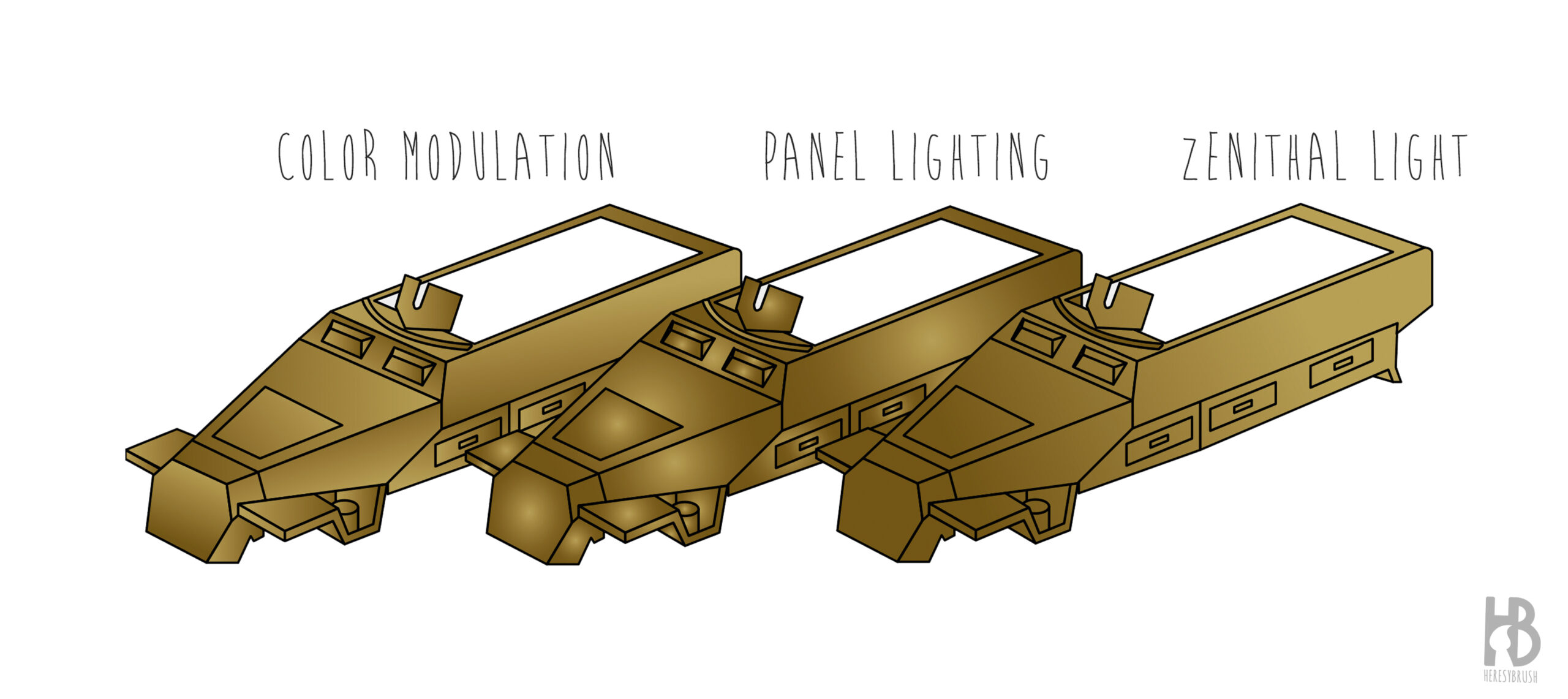 We will apply an elaborate highlight system to the basic dark yellow of these German vehicles, known as color modulation (refer to the previous guide). This technique will help create contrast and partially compensate for the flat green camouflage spots applied on top, as the shadows and highlights on the dark yellow will still create some volume. There are other simpler options, such as classical zenithal lighting (imagine a single light source above the miniature, like the sun). However, I find the unrealistic results of color modulation more beneficial when painting 15mm vehicles, as it helps them stand out. You can read more about this topic lightning systems and color modulation here and here.
We will apply an elaborate highlight system to the basic dark yellow of these German vehicles, known as color modulation (refer to the previous guide). This technique will help create contrast and partially compensate for the flat green camouflage spots applied on top, as the shadows and highlights on the dark yellow will still create some volume. There are other simpler options, such as classical zenithal lighting (imagine a single light source above the miniature, like the sun). However, I find the unrealistic results of color modulation more beneficial when painting 15mm vehicles, as it helps them stand out. You can read more about this topic lightning systems and color modulation here and here.
However, this is not compulsory. You can follow this guide using any other highlighting system, including a simple drybrush or even a plain color (if you decide to use this last option, it is advisable to use a slightly lighter color than the real one to compensate for the small size of this vehicles).
Step 1: Preparation
After carefully cleaning each plastic piece, we assemble them using plastic cement. I used a colored glue (Night Blue Cement A.MIG-2045) to help see where and how much glue is being applied, and to detect any gaps that might need to be filled with modeling putty. When painting a platoon of multiple vehicles, it’s a good idea to customize them a bit to make each one unique. I used 3D-printed boxes, jerry cans, and rolled tarpaulins, and sculpted blankets with green stuff. Additionally, we can add antennas using a 0.2mm nickel-silver rod (Albion Alloys) fixed with instant glue.
Step 2: Primer
Once the plastic kits are fully assembled and customized, we apply the primer or undercoat. This step is essential as it facilitates the application of paint and increases its durability. Since we are painting the halftracks in dark yellow, we use a similar color for the primer. A spray can, such as TITANS Desert Yellow Primer TTH111, works well for this purpose. Although it’s not the exact color we need, it will be much easier to cover later with the correct color. Starting with a black or white undercoat would require multiple layers of the base color to achieve an even surface.
Step 3: Dunkelgelb shadow
The Germans painted their tanks in dark yellow at the factory after 1943, with the camouflage spots (green or brown) often applied by the crews themselves. Following this method, we start by painting the entire vehicle in dark yellow. We begin with a darker shade than needed to serve as the “shadow.” For example, we can use IONIC-1006 Dunkelgelb Dark Base (or 80% ATOM-20012 Dunkelgelb with 20% ATOM-20064 Chipping ) to evenly cover the entire vehicle using an airbrush.
Step 4: Dunkelgelb base
Next, we apply the base color, IONIC-1007 Dunkelgelb (or ATOM-20012 Dunkelgelb ). Using the airbrush, we begin creating the color modulation by painting highlights individually on each large panel to achieve high contrast. This involves placing the maximum highlight of one panel adjacent to the maximum shadow of another.
Step 5: Dunkelgelb light I
We apply a single highlight using a lighter color, for example, by mixing 70% IONIC-1007 Dunkelgelb with 30% IONIC-0009 Bone (or 80% ATOM-20012 Dunkelgelb with 20% ATOM-20000 Matt White). This highlight is applied to the previously highlighted areas, but with a reduced coverage area. It is essential that all layers and colors remain visible in the final result.
Step 6: Dunkelgelb light II
The color modulation is completed using a brush. The final step involves using an even lighter color, mixing 40% IONIC-1007 Dunkelgelb with 60% IONIC-0009 Bone (or 40% ATOM-20012 Dunkelgelb with 60% ATOM-20000Matt White ). This mixture is used to paint all the small details, such as rivets, wrinkles, and upper edges.
Step 7: Brown soft-edge camouflage
Once the base color is ready, we can apply the camouflage spots. I decided to paint a simple camo with brown spots using IONIC-1004 Schokobraun RAL 8017 (or ATOM-20062 Schokobraun). When painting this type of camo, we must dilute the paint with at least 40% acrylic thinner to create a semi-transparent mixture that gives us more control over the intensity. Then, using an airbrush set to a pressure of 2 bars (60 psi), we paint random spots here and there. Instead of painting small circles or dots, we aim to create irregular shapes, thinking of patterns similar to letters like X or Y. It is advisable to test the dilution and our skills on a piece of paper before applying the paint to the vehicle.
Step 8: Details
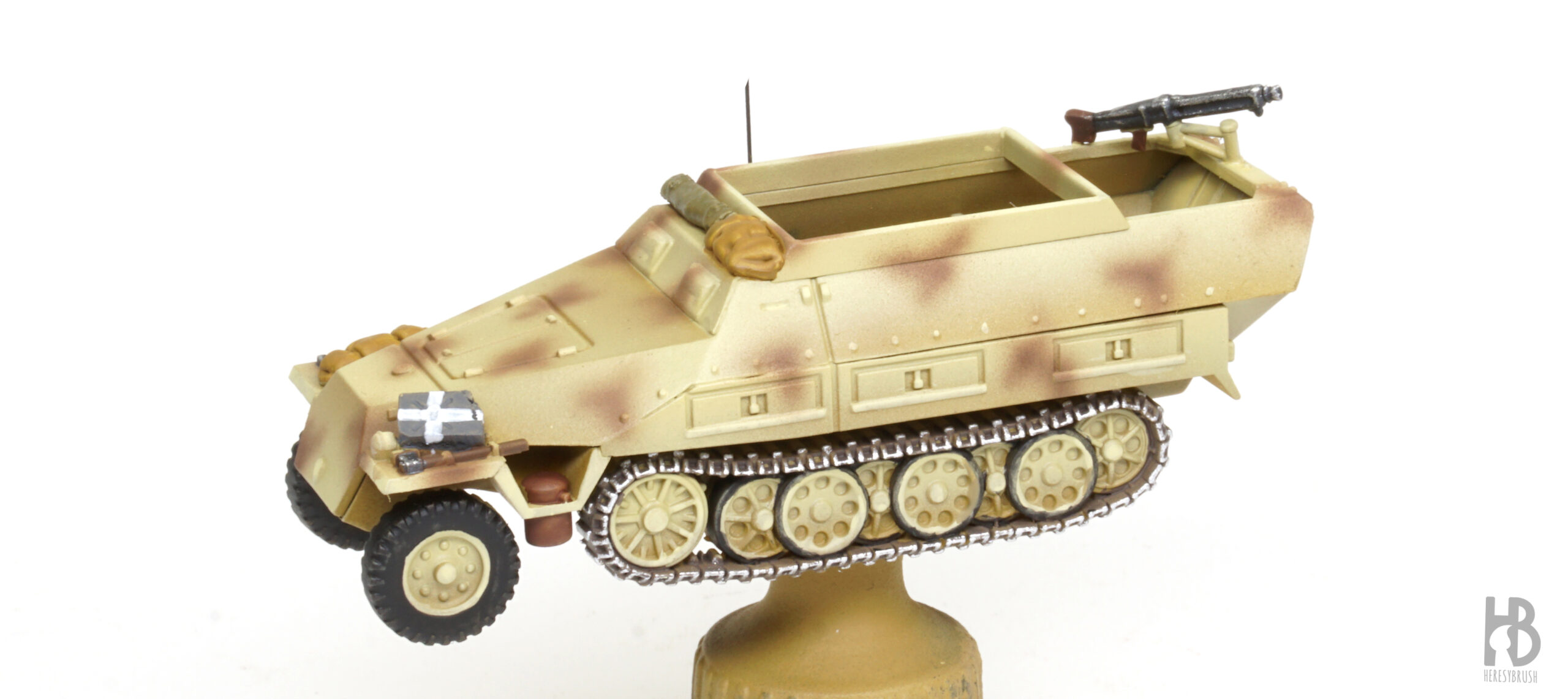 Next, we paint the remaining parts of the vehicle using a brush and paint thinned with 20% water to facilitate application. We use IONIC-0172 Black for the wheels and the rubber of the tracks, while the tracks are first painted with IONIC-0148 Graveyard Earth (or 1:1 mix of ATOM-20144 Zimmerit and ATOM-20064 Chipping ). Once dry, we apply a drybrush with IONIC-0173 Black Metal to create a metallic shine. Similarly, the MG is painted, starting with black. For the blankets and tarpaulins, we use different shades of brown, such as IONIC-0154 Brown (or ATOM-20051 Earth), while for the jerry can in this example, we use grey and then paint a white cross to indicate it contains water. For the exhaust, we use IONIC-0156 Rust (or ATOM-20047 Dark Rust).
Next, we paint the remaining parts of the vehicle using a brush and paint thinned with 20% water to facilitate application. We use IONIC-0172 Black for the wheels and the rubber of the tracks, while the tracks are first painted with IONIC-0148 Graveyard Earth (or 1:1 mix of ATOM-20144 Zimmerit and ATOM-20064 Chipping ). Once dry, we apply a drybrush with IONIC-0173 Black Metal to create a metallic shine. Similarly, the MG is painted, starting with black. For the blankets and tarpaulins, we use different shades of brown, such as IONIC-0154 Brown (or ATOM-20051 Earth), while for the jerry can in this example, we use grey and then paint a white cross to indicate it contains water. For the exhaust, we use IONIC-0156 Rust (or ATOM-20047 Dark Rust).
Step 9: Decals and sealing with glossy varnish
Now, if desired, we can apply decals before adding the weathering effects. We have previously explained the decal application process (see “How to Apply Decals“). To protect the decals and prepare the surface for weathering effects, apply a couple of thin layers of glossy varnish, such as A-STAND Aqua Gloss Clear A.MIG-2503. The glossy varnish creates a smooth and polished surface, ensuring optimal application and distribution of the wash.
Step 10: dark wash (enamel)
So far, we have used acrylic paints, which dry in seconds and can be thinned with water. Now, we will switch to enamel paint. This type of paint, like oils, dries in hours and requires a solvent such as turpentine for use. Although these properties might seem disadvantageous (well, they are), the significant advantage of enamels over acrylics is the ability to easily remove excess paint, which is crucial for this step. Acrylics, once dry after a few seconds, cannot be removed. You can read more about this topic here.
Following this approach, we use a dark brown wash, such as Dark Brown Wash for Green Vehicles A.MIG-1005, to apply a pin wash. This involves applying the dark wash exclusively to the recesses using a thin brush. While we can remove any excess wash later, the cleaner we are at this step, the quicker and easier the next steps will be.
Step 12: removing the excess of wash
After waiting 30-60 minutes for the enamel wash to partially dry (it will fully dry after several hours), we remove the excess wash using a brush or cotton swab moistened with Enamel Odourless Thinner A.MIG-2019. We do this gently, avoiding the removal of paint from the recesses. To achieve this, we rub the surface in the opposite direction of the recesses when possible. It doesn’t need to be perfect; we just need to create some contrast.
Step 13: sealing with flat varnish
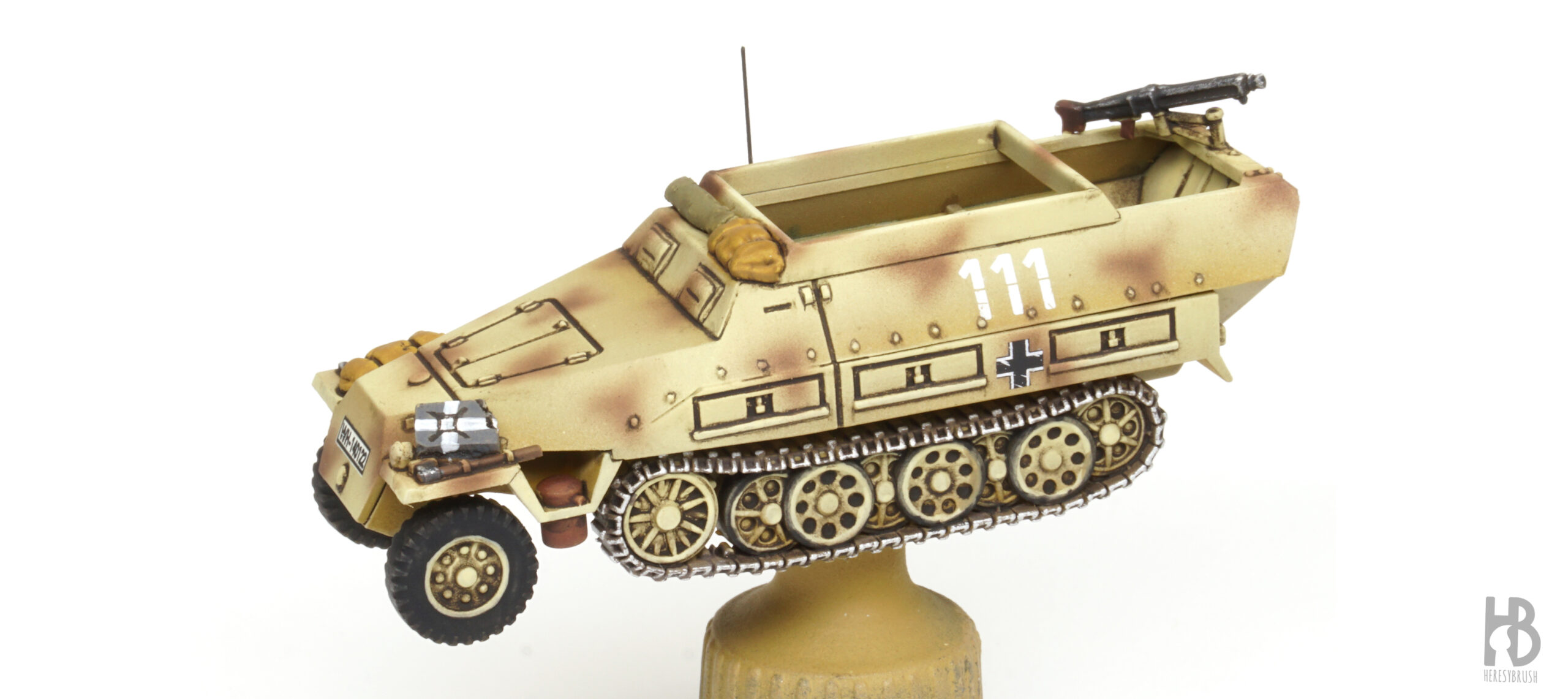 Optionally, we can use a thin brush and an acrylic dark brown paint to touch up areas where we have removed too much wash or where the details are not deep enough. This helps to enhance definition and cleanliness, but it is not compulsory. Otherwise, we eliminate the glossy effect by applying a couple of layers of Ultra-Matte Lucky Varnish A.MIG-2054.
Optionally, we can use a thin brush and an acrylic dark brown paint to touch up areas where we have removed too much wash or where the details are not deep enough. This helps to enhance definition and cleanliness, but it is not compulsory. Otherwise, we eliminate the glossy effect by applying a couple of layers of Ultra-Matte Lucky Varnish A.MIG-2054.
Step 14: chipping effects I
 We create chipping effects in two steps. First, we use a light color to represent superficial chipping effects and scratches, and then a dark brown to simulate deeper ones, exposing the bare metal underneath. We start with the former. Using the lighter color from the color modulation (40% IONIC-1007 Dunkelgelb with 60% IONIC-0009 Bone or 40% ATOM-20012 Dunkelgelb with 60% ATOM-20000Matt White ) and a thin brush, we paint small dots and lines primarily on the edges and some long lines representing scratches on the vertical surfaces.
We create chipping effects in two steps. First, we use a light color to represent superficial chipping effects and scratches, and then a dark brown to simulate deeper ones, exposing the bare metal underneath. We start with the former. Using the lighter color from the color modulation (40% IONIC-1007 Dunkelgelb with 60% IONIC-0009 Bone or 40% ATOM-20012 Dunkelgelb with 60% ATOM-20000Matt White ) and a thin brush, we paint small dots and lines primarily on the edges and some long lines representing scratches on the vertical surfaces.
Step 15: chipping effects II
We repeat the same process using a dark brown, such as IONIC-0160 Black Brown (or ATOM-20064 Chipping). The idea is to place the dark color inside or around the light chipping effects to give them volume and create a three-dimensional effect. However, we will preserve some of the light chipping effects without the dark tone to add variety. When applying chipping effects, it’s crucial to control the size and number: these effects should be super small and thin, and we should not cover every single edge of the vehicle. The more variety, the better.
Step 16: Accessories
Now, we finish by painting the accessories of the vehicle, such as the blankets, tarpaulins, tools, etc. We use acrylic paints and our preferred painting technique, such as the base + wash + highlight method that we discussed previously (Painting WWI French Fusiliers: Combining Quick Washes and Advanced Layering). We can also add chipping effects on the exhausts using a lighter rust tone such as IONIC-0155 Light Rust (or ATOM-20045 Light Rust).
Step 18: Pigments
The best tool to create dust effects is pigments, which are essentially colored powders. While you can use any given color directly, it is advisable to mix a few shades to create a richer blend. Pigments, unlike regular paints, do not completely merge, maintaining their individual colors even in a complex mix. This results in a more interesting and realistic effect. Depending on the result we are looking for, we mix the corresponding pigments. Here, we picked Europe Earth A.MIG-3004, Winter Soil A.MIG-3029 and Track Rust A.MIG-3008.
Step 8: Pigments wash
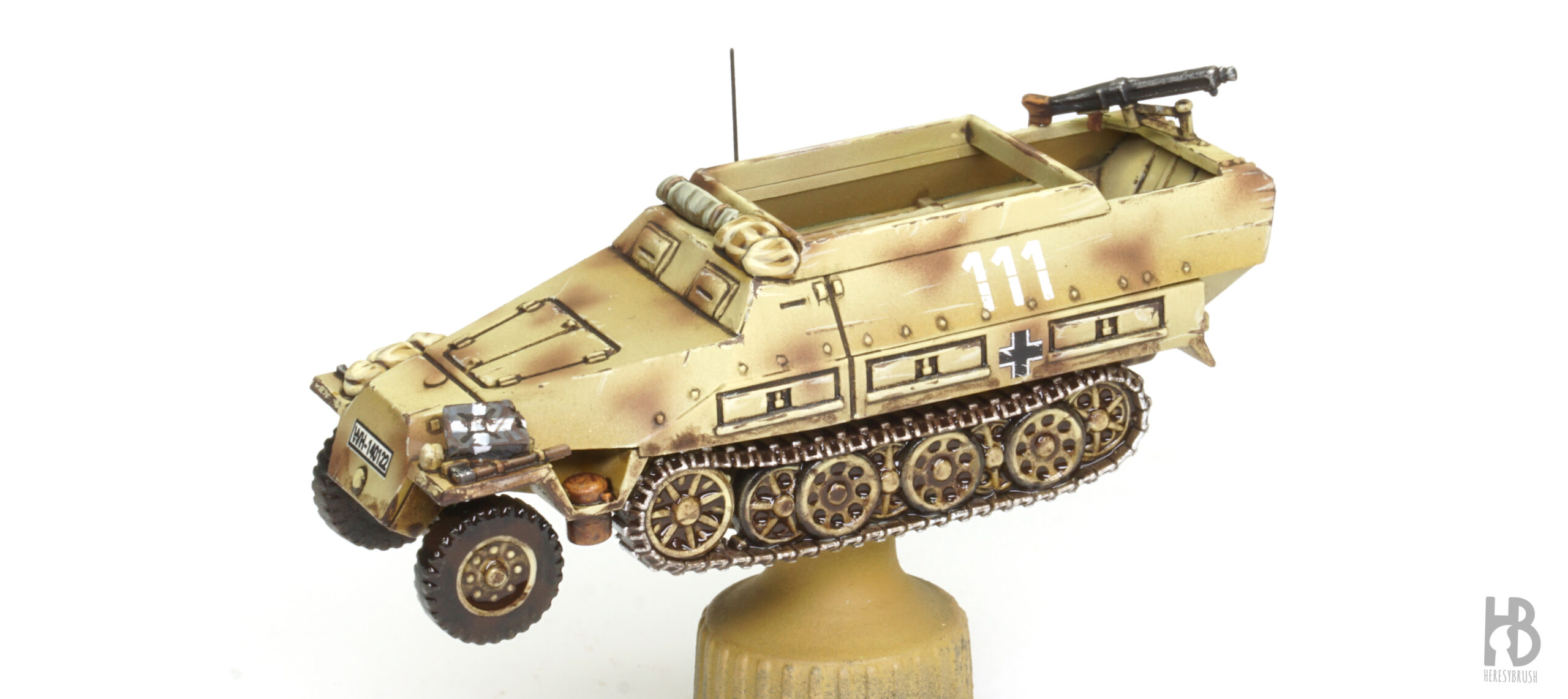 Pigments can be applied in two ways: dry, directly from the jar, or wet, suspended in water or thinner. The dry method is ideal for creating superficial dust effects, while the wet method can create accumulations in recesses. Here, we aim for the latter, to accumulate dust on the tracks and wheels. To do this, we mix the pigments with 50% Enamel Odourless Thinner A.MIG-2019 and apply the wet pigments as a wash over the tracks, wheels, and lower part of the hull.
Pigments can be applied in two ways: dry, directly from the jar, or wet, suspended in water or thinner. The dry method is ideal for creating superficial dust effects, while the wet method can create accumulations in recesses. Here, we aim for the latter, to accumulate dust on the tracks and wheels. To do this, we mix the pigments with 50% Enamel Odourless Thinner A.MIG-2019 and apply the wet pigments as a wash over the tracks, wheels, and lower part of the hull.
Step 19: Remove excess of pigments
We let the pigments dry completely for several hours or overnight, allowing them to regain their dusty and ultra-matte appearance. Then, we use a brush to gently rub the surfaces, removing the excess pigment and spreading it over the exposed parts (note that when applying the wet pigments, we accumulated them in the recesses, avoiding the more exposed areas). For a more pronounced effect, especially on the wheels where we want the pigment to gather in the detailing, we can remove a larger portion of the pigment using a finger.
Step 20: Crew
The half-track is ready, and it is time to paint the crew. For this, you can use your favorite painting technique for figures, such as Painting WWI French Fusiliers: Combining Quick Washes and Advanced Layering. Once ready, we fix the crew in place using instant glue. When painting platoons, it is important to vary the positions of the crew members in each vehicle to add variation. Here, I also added a third crew member in some half-tracks, seated on the bench.
Step 11: Foliage camouflage I
Although our half-tracks are now finished, we can optionally add 3D camouflage in the form of foliage. This was a common method of rapid camouflage, using branches from trees or bushes. To simulate this in a tiny scale, we need to use appropriately small materials. To create the skeleton of the branches, we can use Teloxys aristata (sometimes called sea moss or sea foam), which is commonly used in train scale modeling. For the foliage itself, we can use various small-grain products, including tiny scale model trees and products designed to simulate moss in larger scales. It is important that whatever we use as leaves or foliage is very small and appropriate for 15mm miniatures. You can read more about this here.
Step 12: Foliage camouflage II
First, we apply a little bit of PVA glue to a small branch of Teloxys aristata, then sprinkle the foliage on top. We create a lot of these and let them dry. Once dry, we select and, if needed, cut the branches to the desired shape or size using modeling cutters. Little by little, we build the foliage camouflage on the vehicle, using PVA glue to fix the branches in place. As we have done before, we will aim to create different patterns on different vehicles to add variation and maintain the individuality of each team in the platoon.
This is the list of paints used in the tutorial:
Acrylics
- IONIC-1201 – WWII German Tanks 1943 – 45 (12 acrylic IONIC paints); or
- ATOM-20012 – Dunkelgelb
- ATOM-20064 – Chipping
- ATOM-20000 – Matt White
- ATOM-20062 – Schokobraun
- ATOM-20144 – Zimmerit
- ATOM-20051 – Earth
- ATOM-20047 – Dark Rust
- ATOM-20045 – Light Rust
- A.MIG-2503 – Aqua Gloss Clear
- A.MIG-2054 – Ultra-Matte Lucky Varnish
Enamels & Weathering Products
- A.MIG-1005 – Dark Brown Wash for Green Vehicles
- A.MIG-2019 – Odorless Enamel Thinner
- A.MIG-3004 – Europe Earth
- A.MIG-3029 – Winter Soil
- A.MIG-3008 – Track Rust
You can get all the paints mentioned above at AMMO by Mig Jimenez website with 10% off using the affiliate code: Heresy10Ionic
Platoon
Using this method I completed last year these two armies:
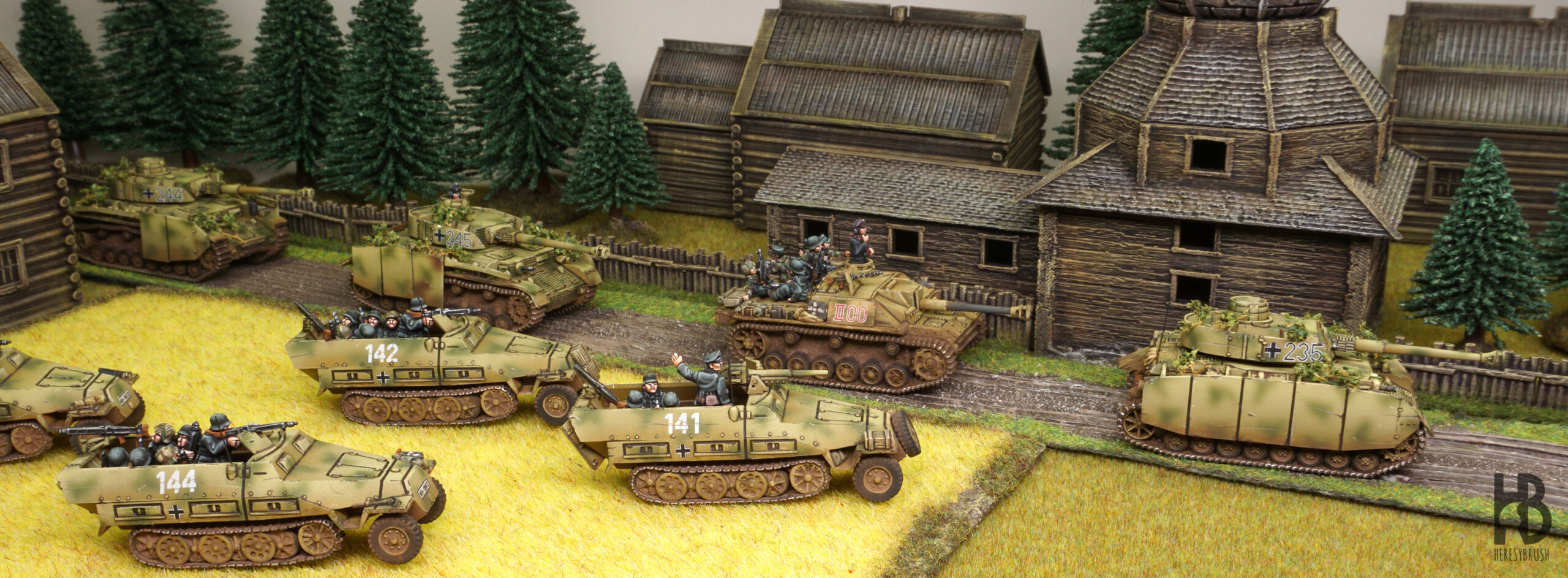


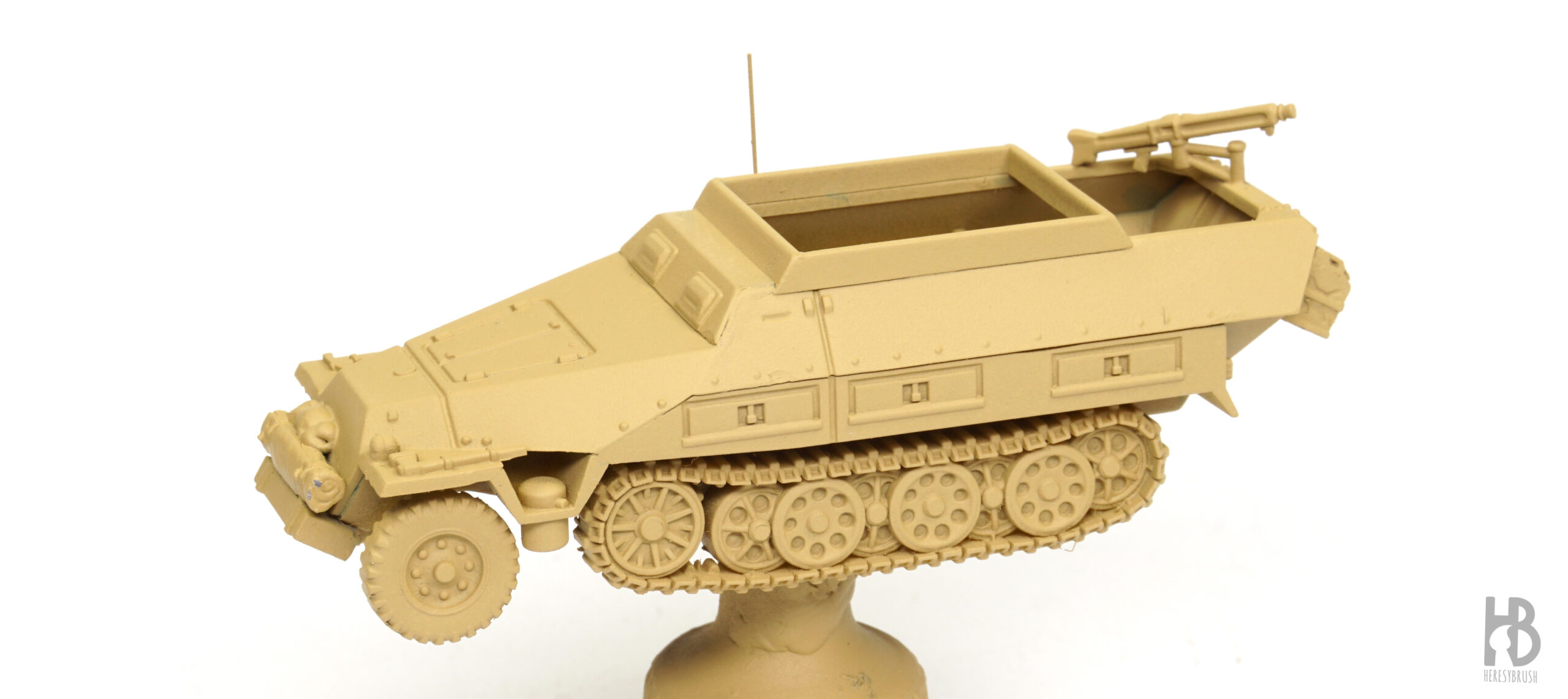
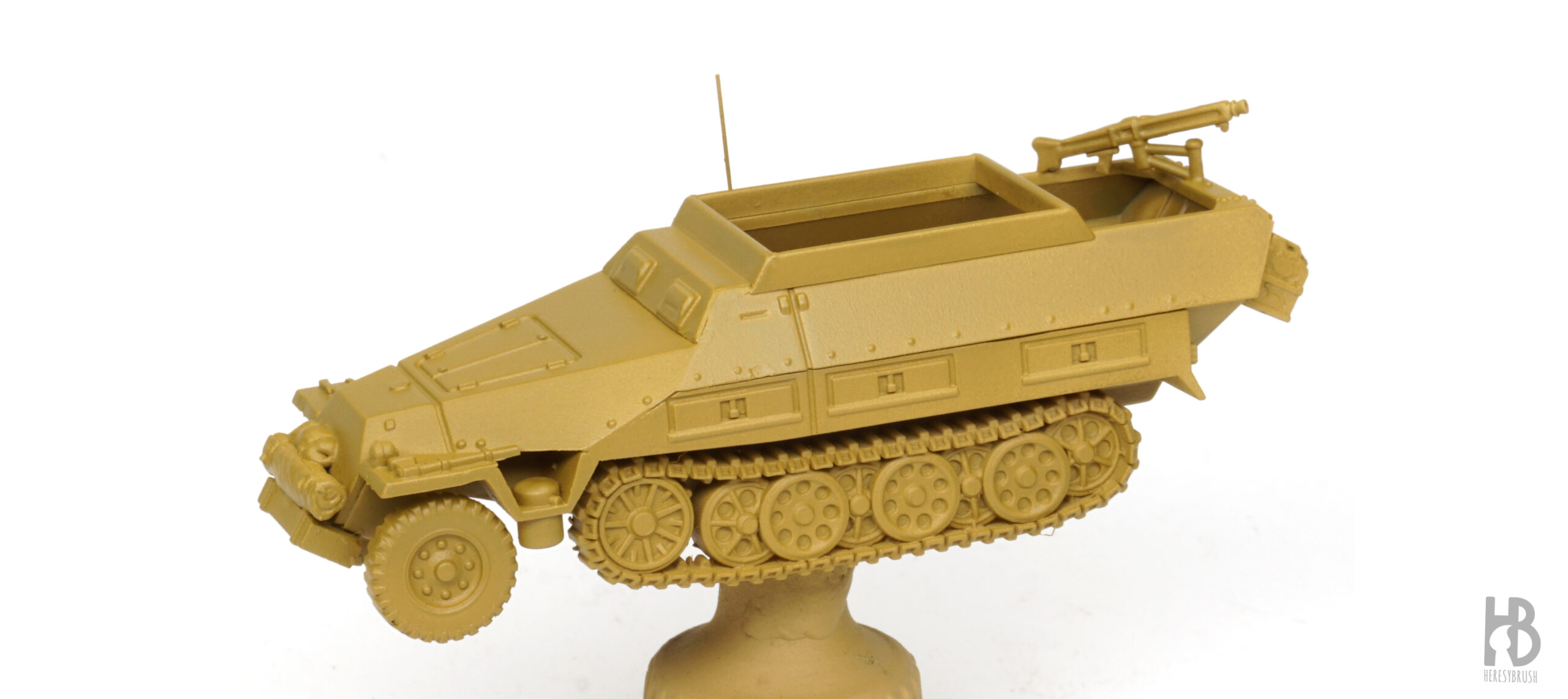
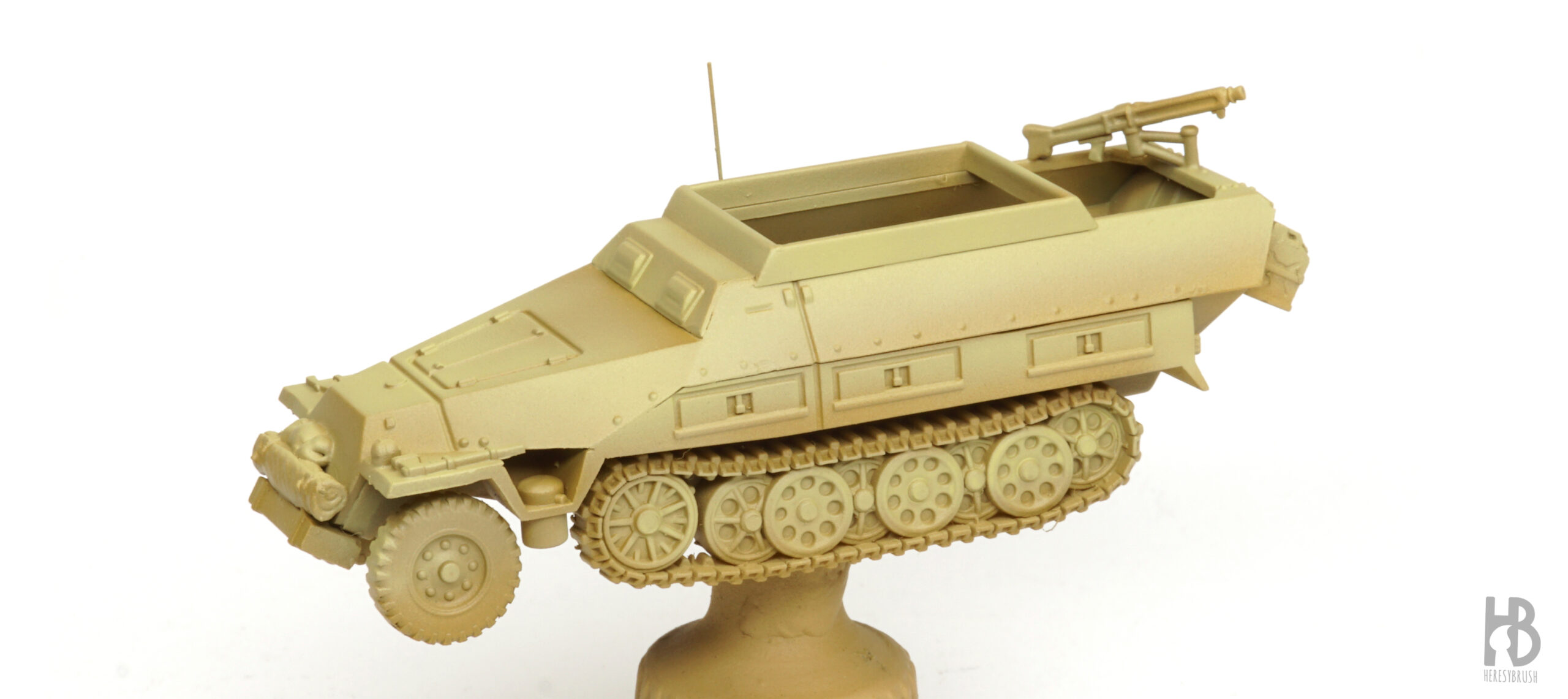
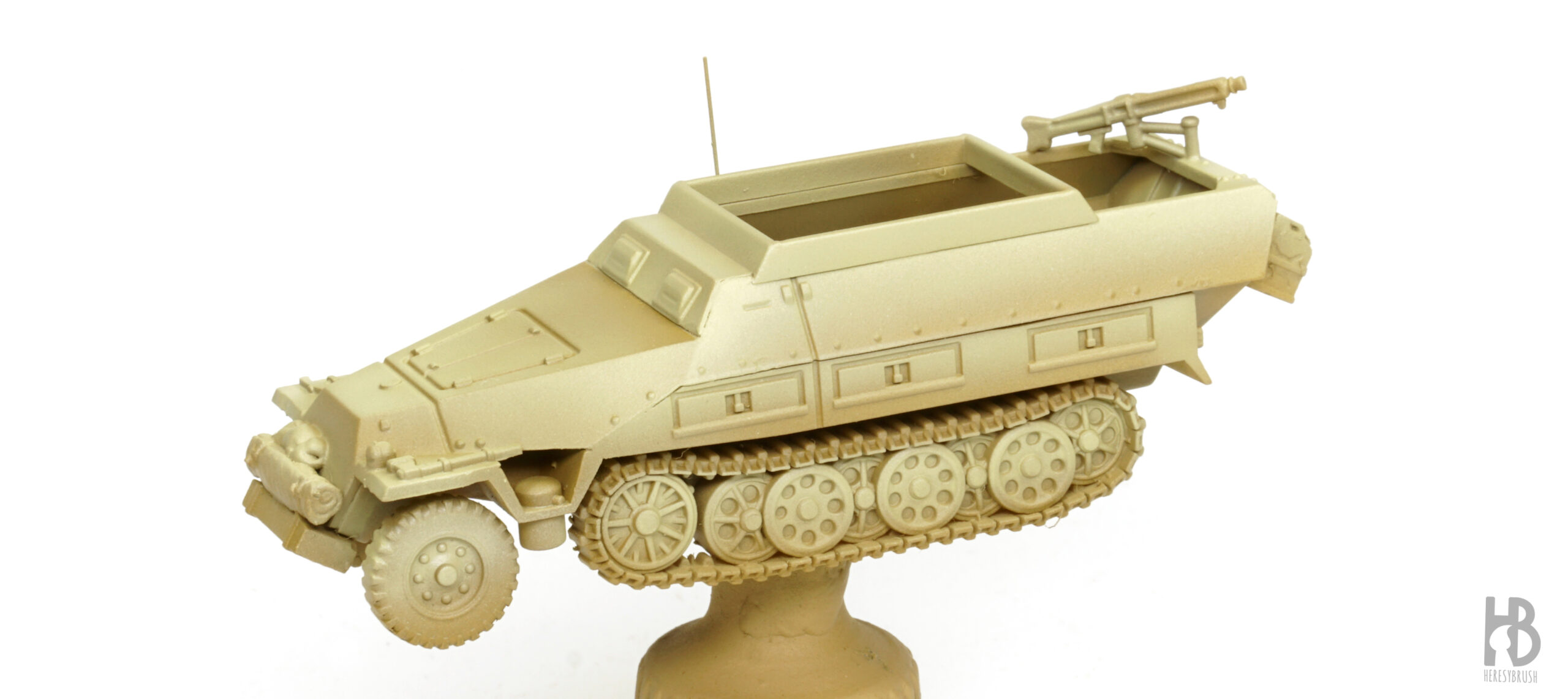
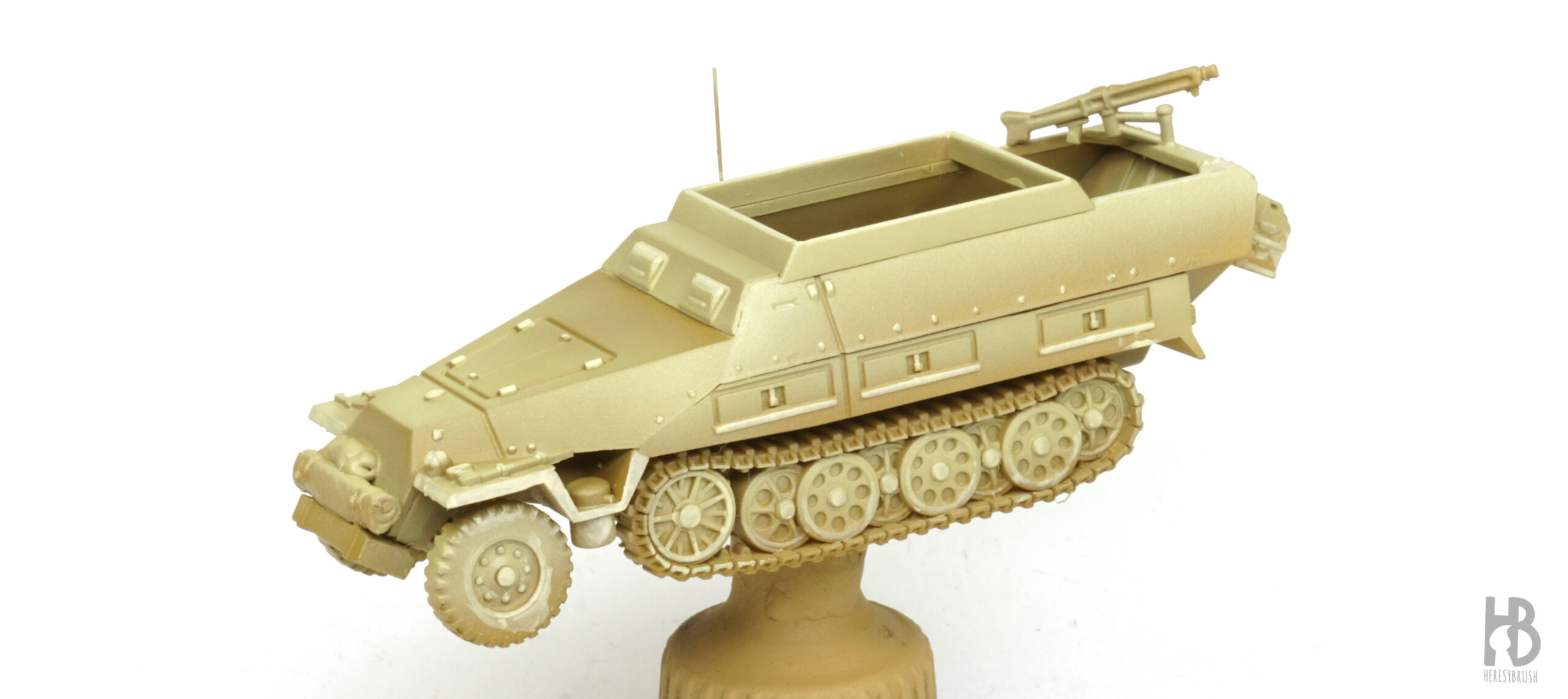
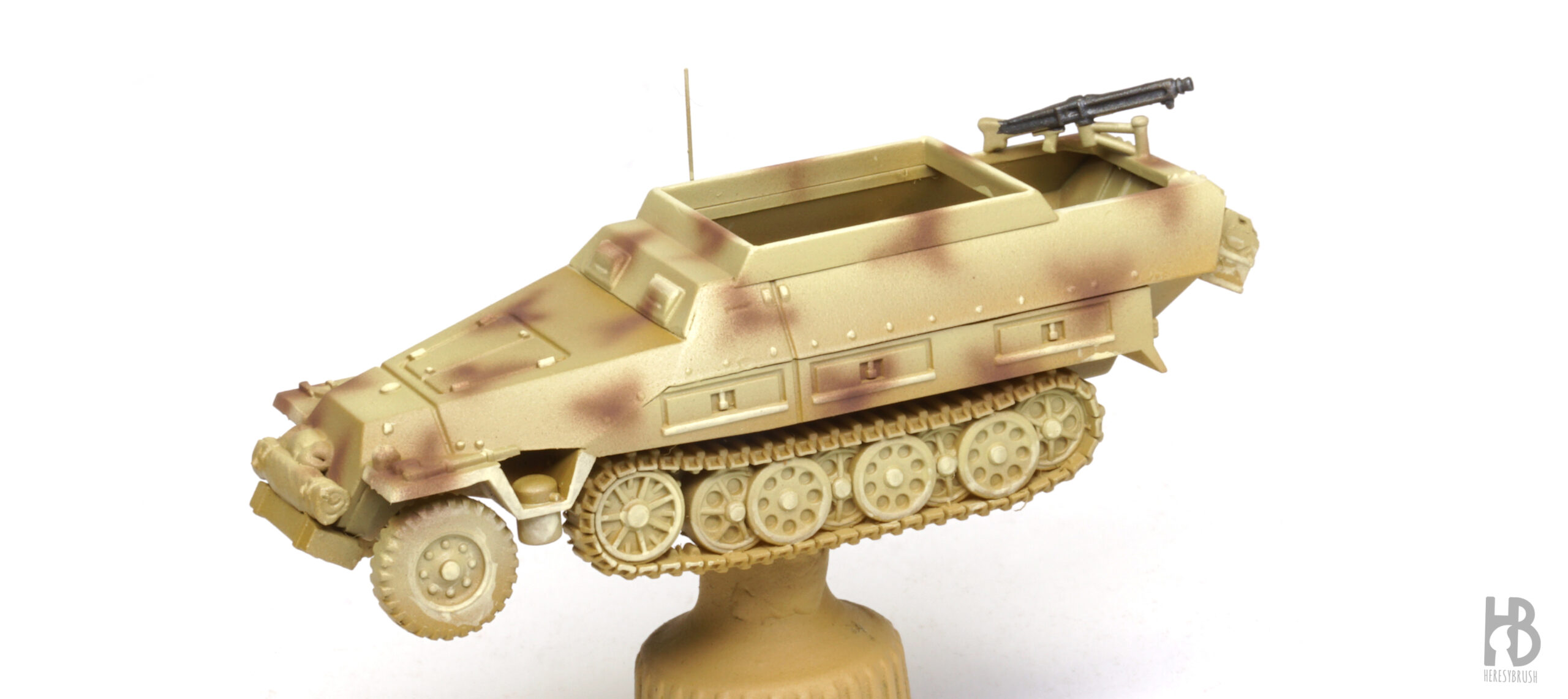

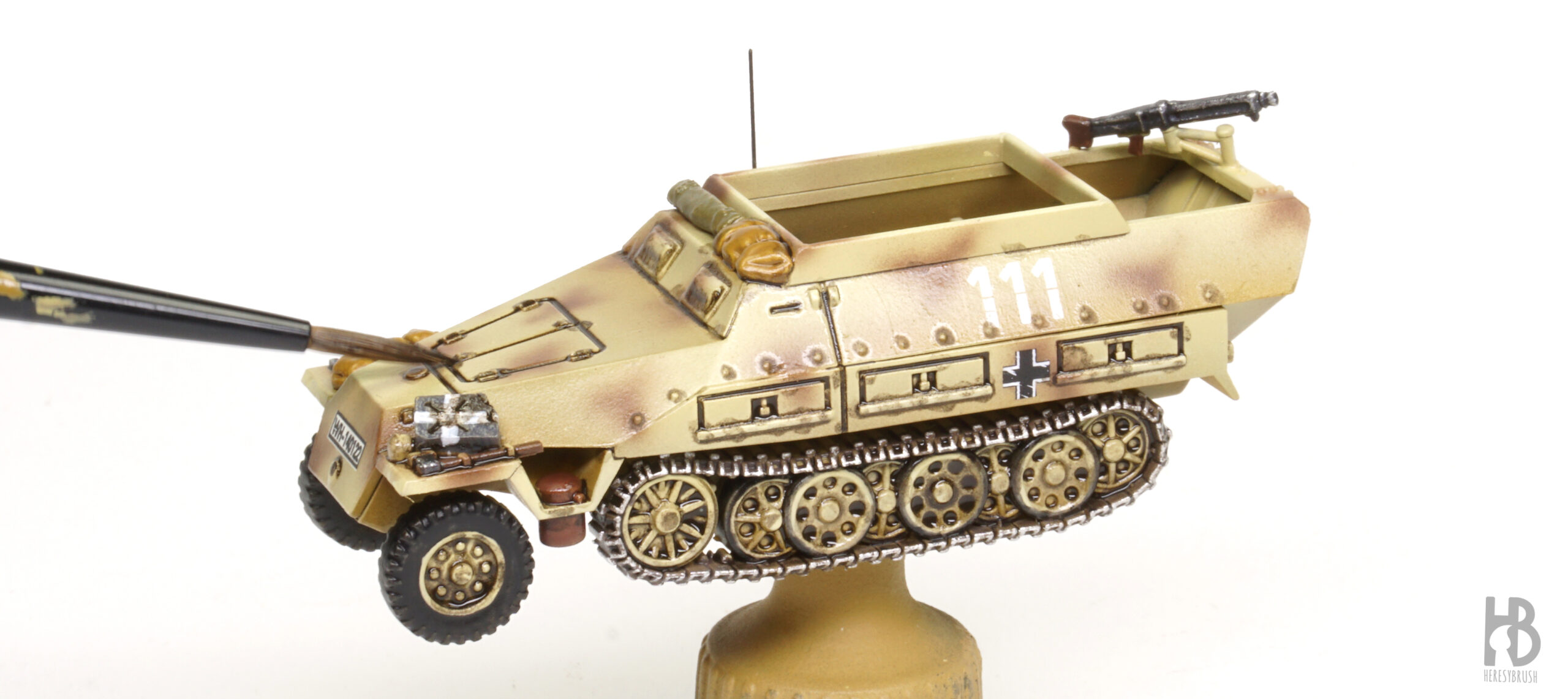
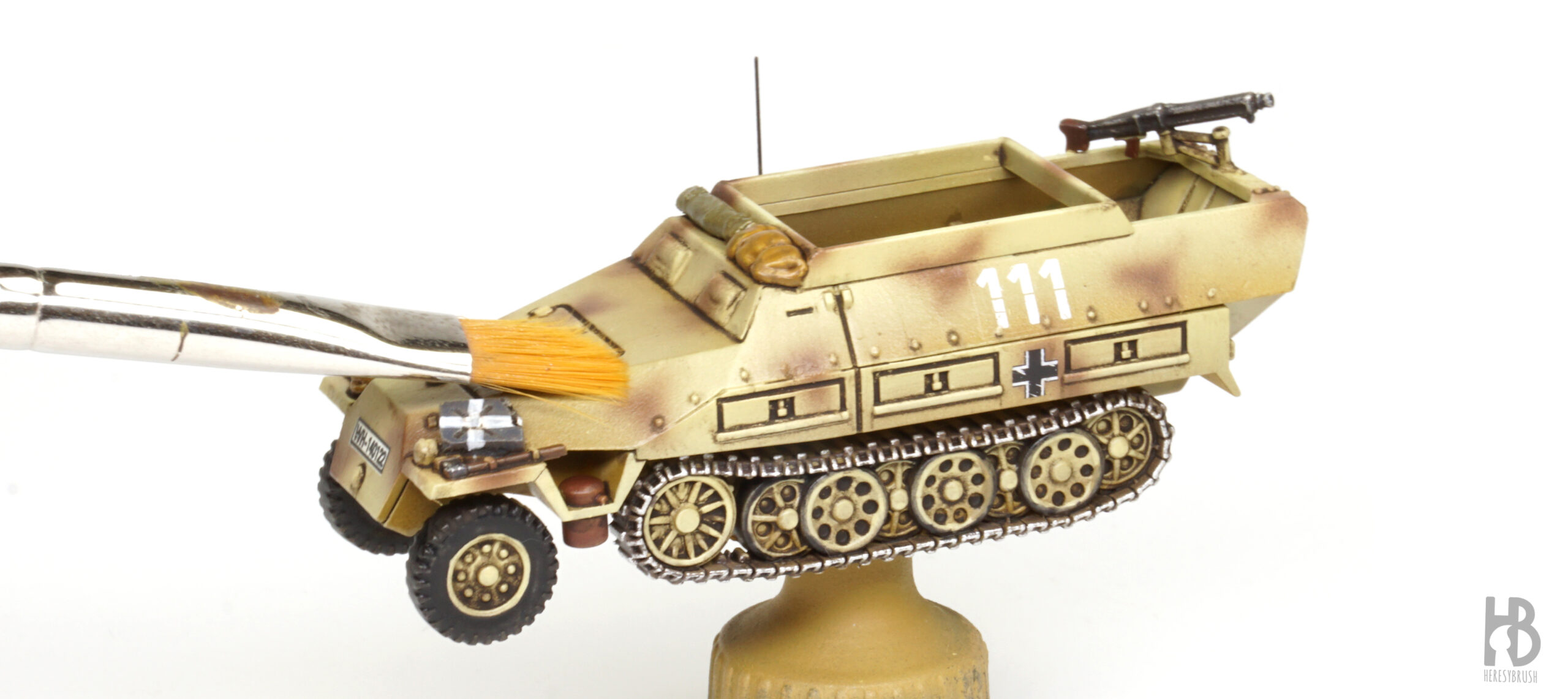
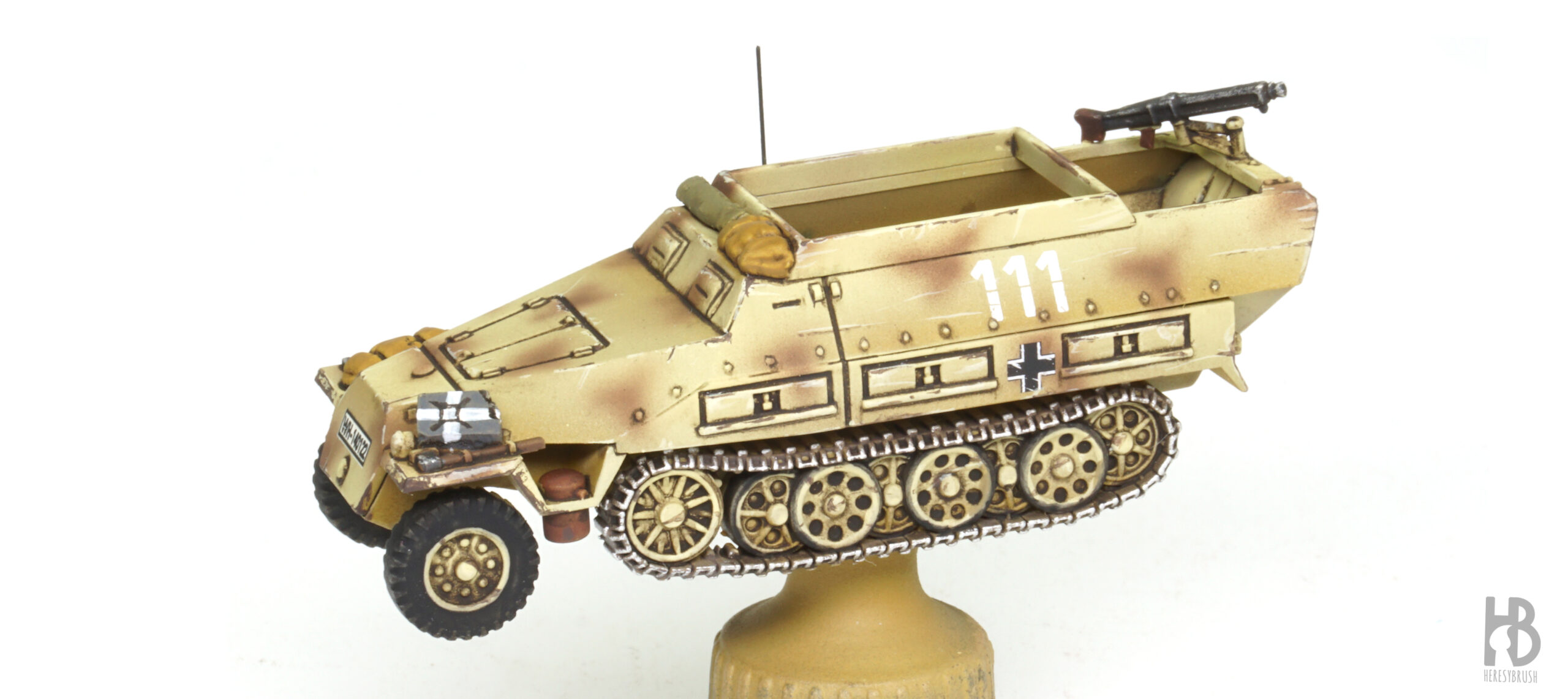

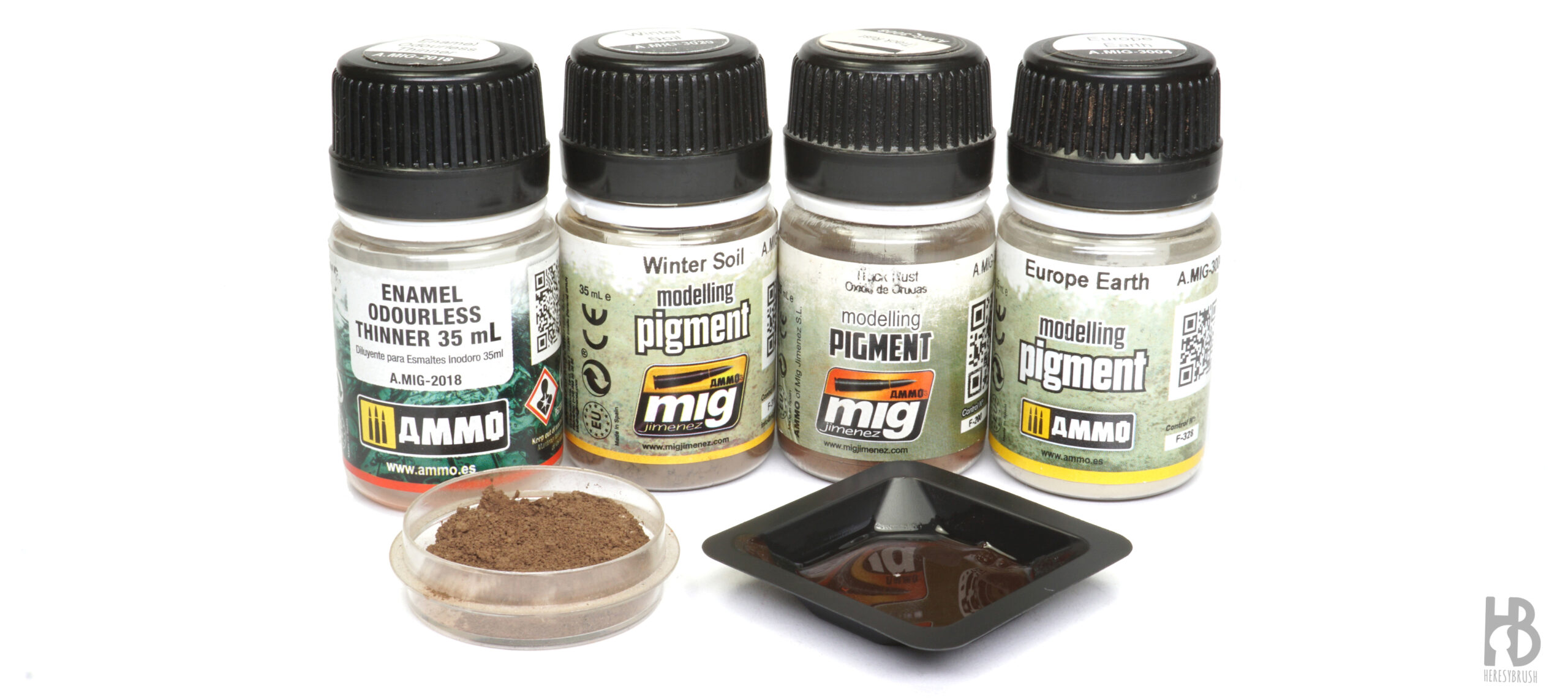
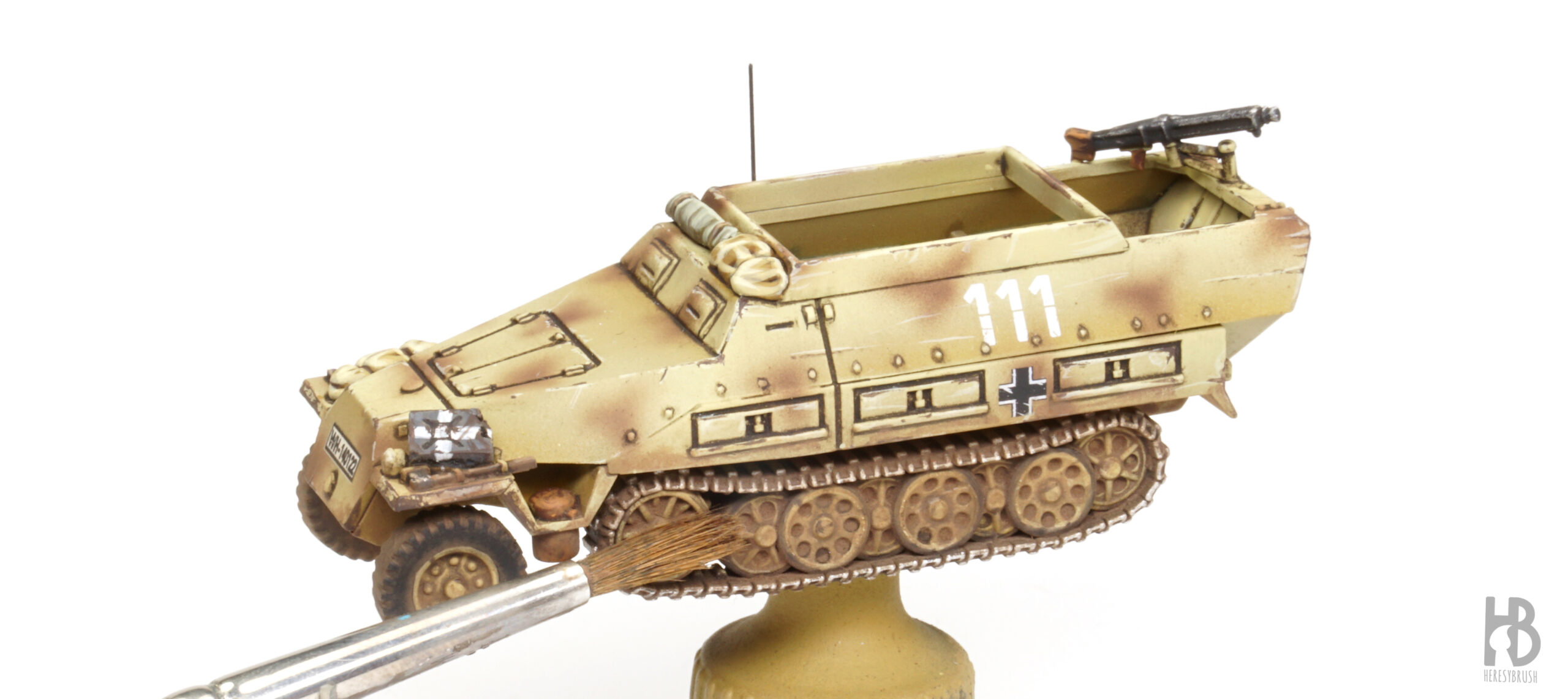
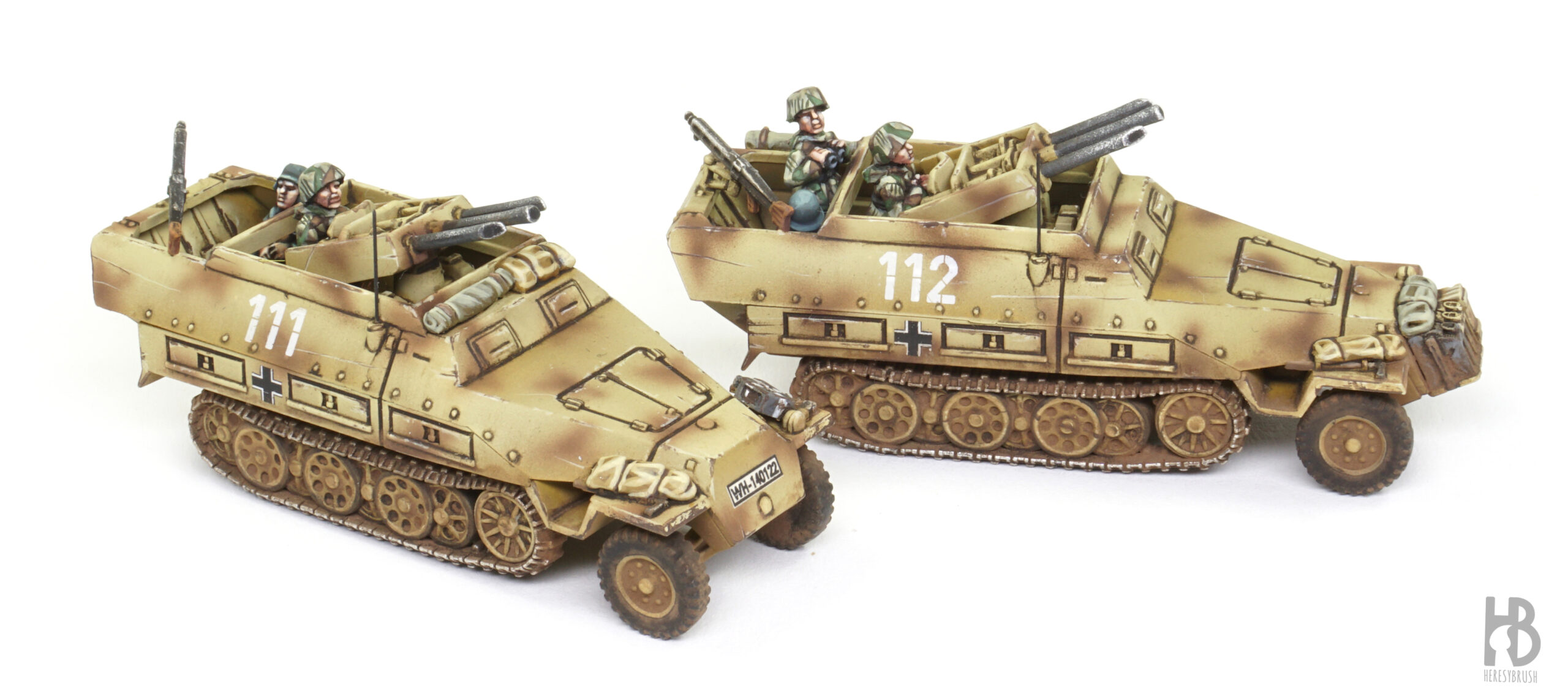

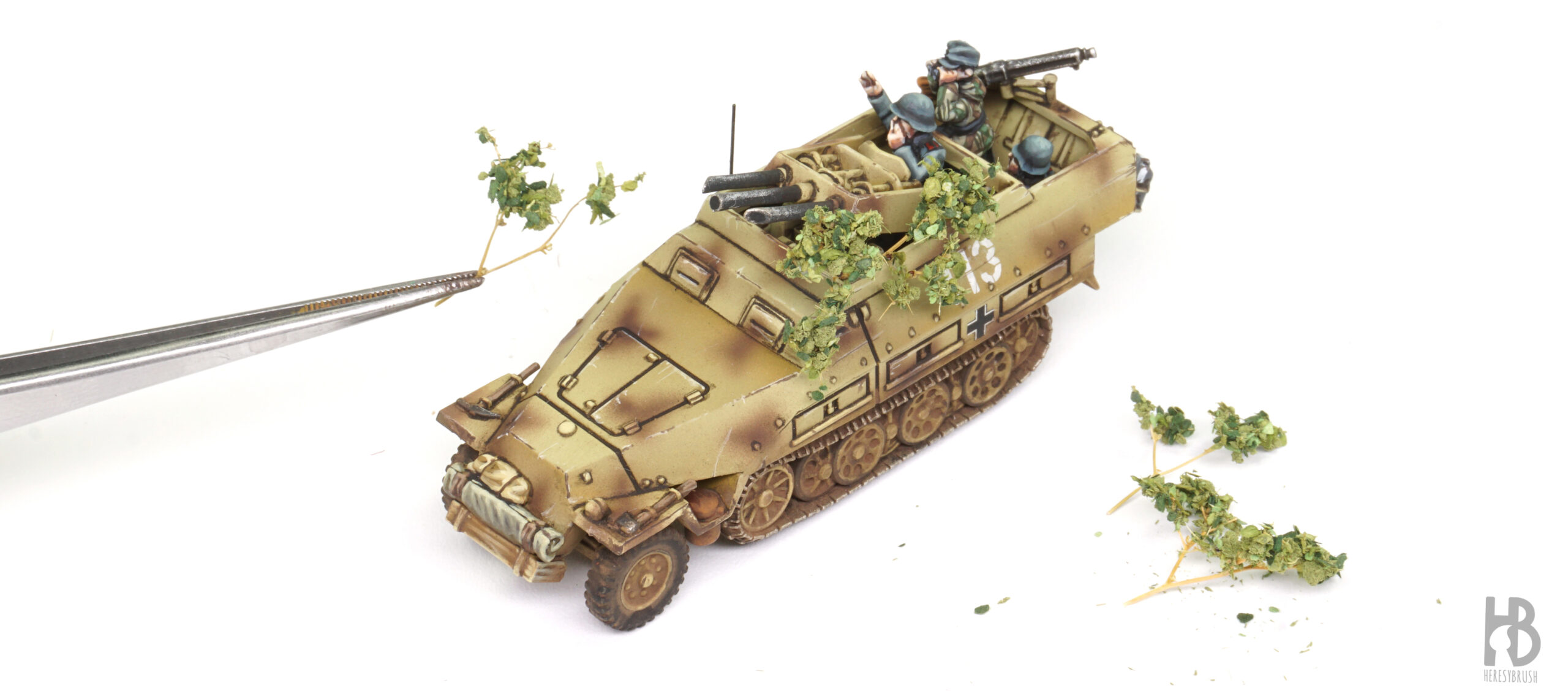

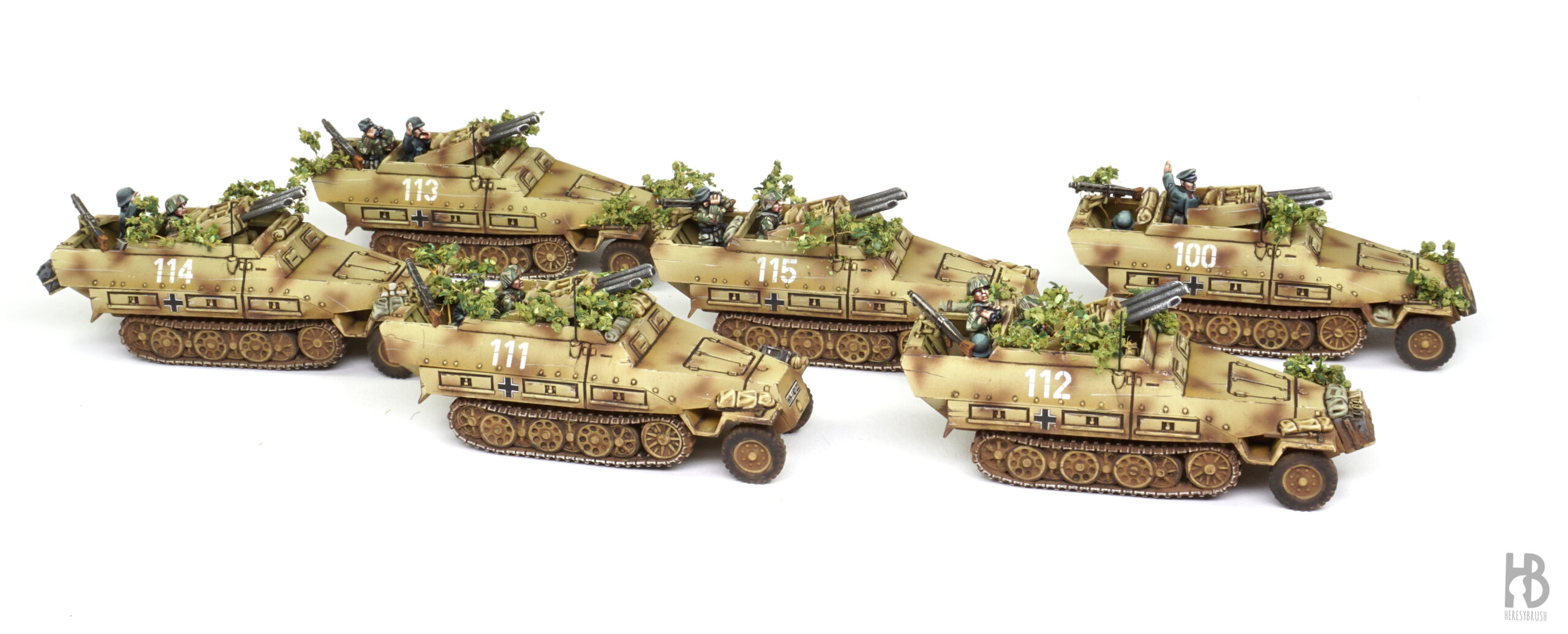
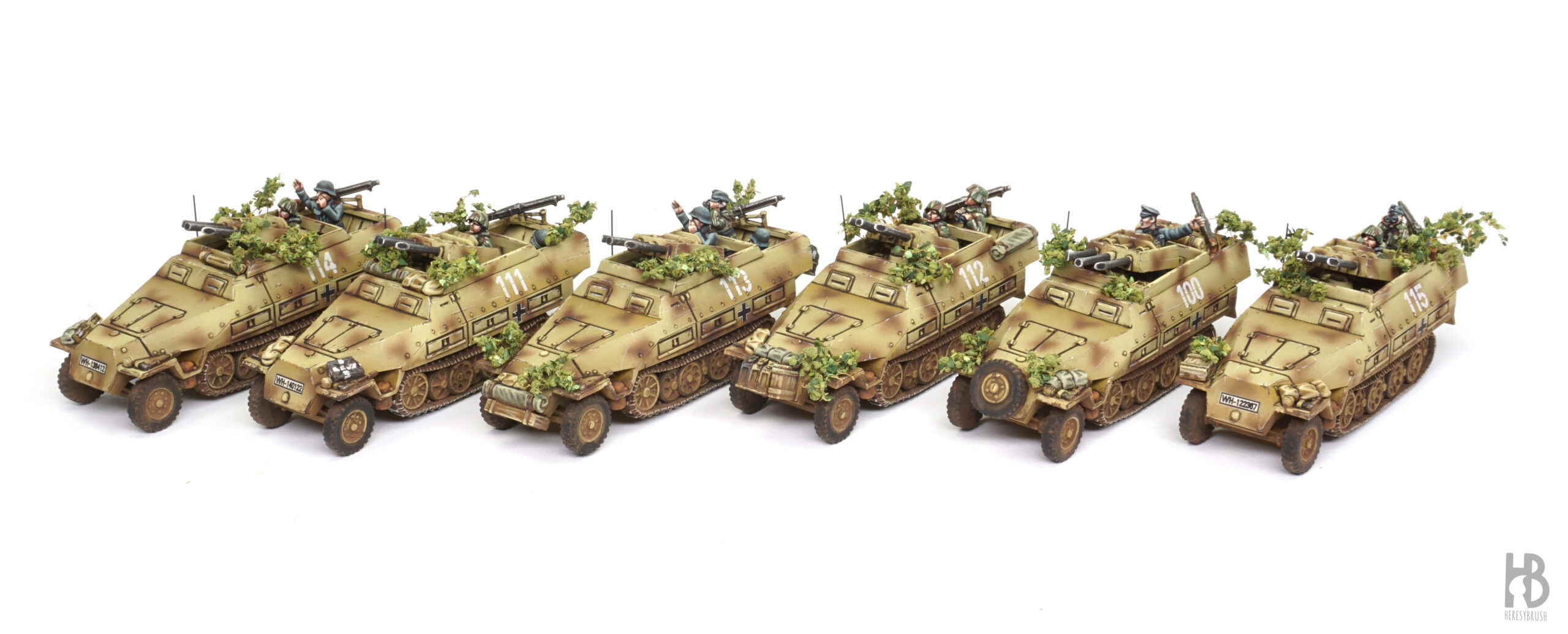
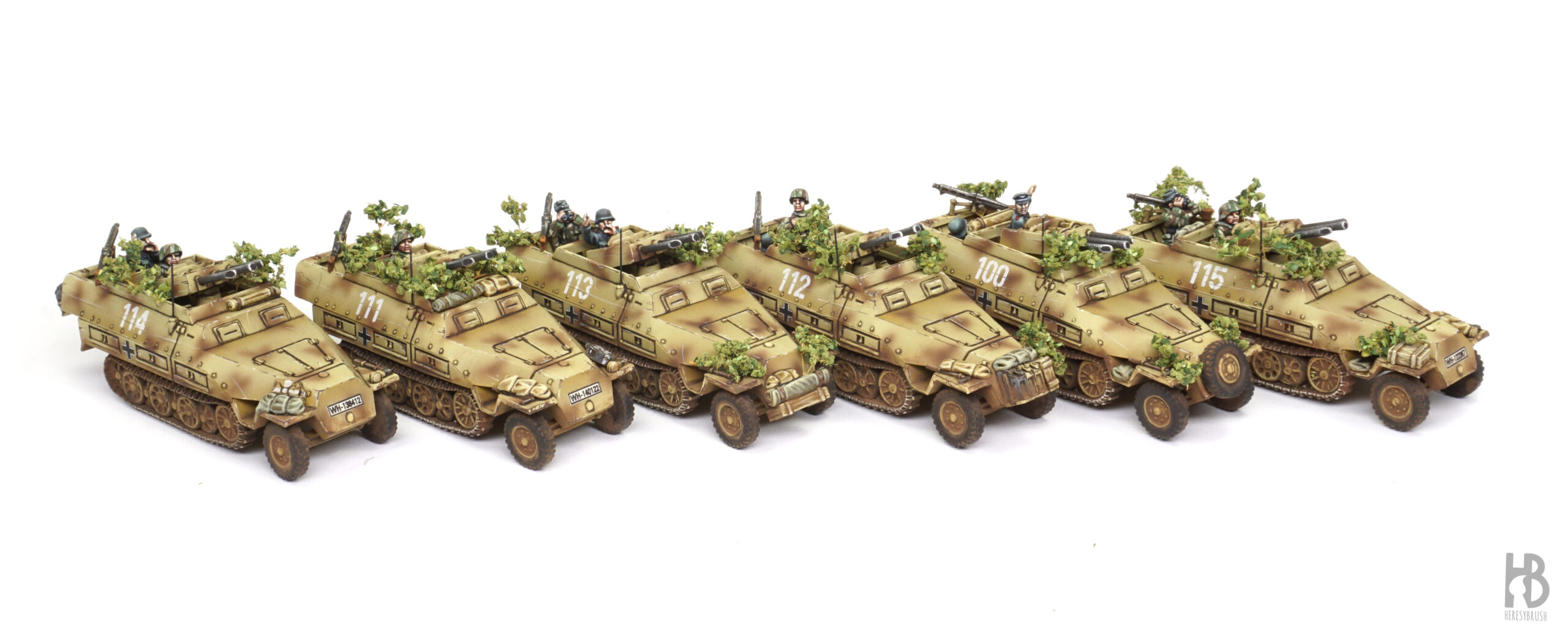
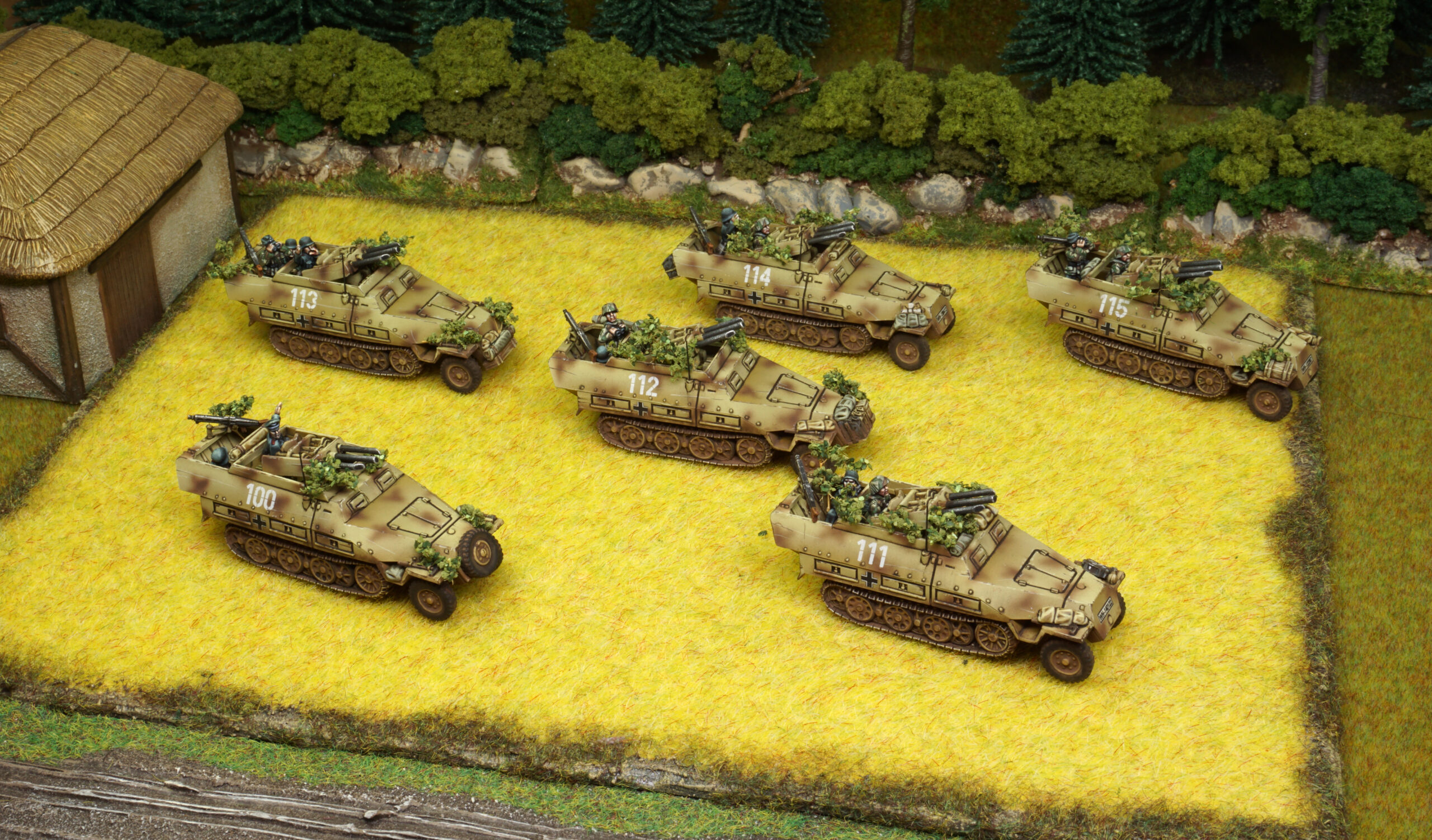

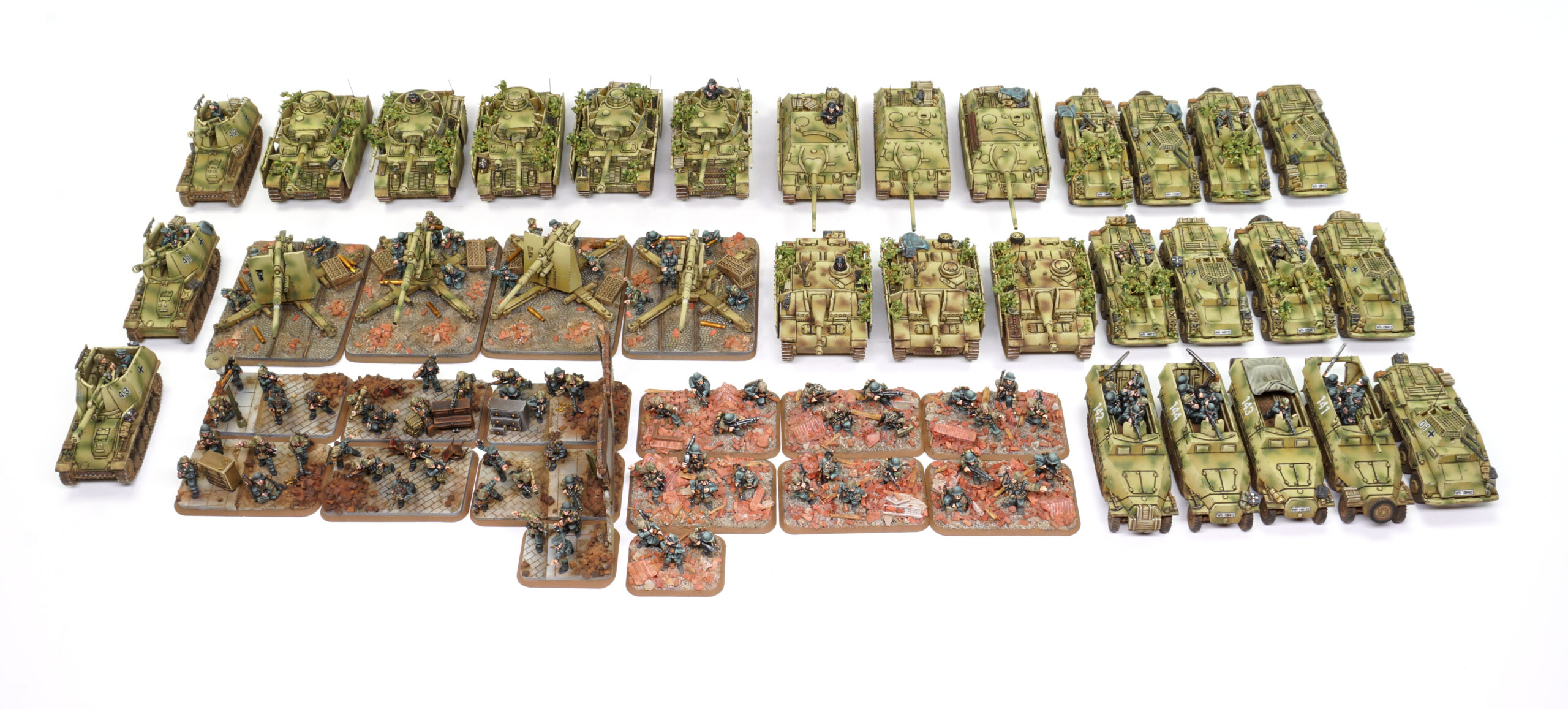
How did you “fix” pigments? Don’t they rub-off while moving vehicles by hand?
They are semi-permanently fixed with the white spirit. For a more durable fixation, you can use “pigment” fixer.
Great work and very clear tutorial, working on 10 SD KFZ right now an testing some new techniques. Thanks !